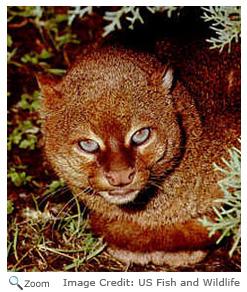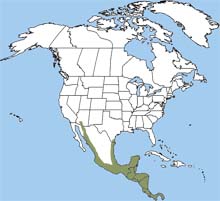Characteristics
 The jaguarundi is small cat that is a little bit larger than a house cat. It is 3 to 4½ feet in length from nose to the tip of its tail and 10-24 inches tall at the shoulders. Its tail can be as long as one to two feet. It weighs 12-18 pounds and has unspotted gray or reddish-brown fur. If it is gray, it will have two white patches under its nose. If it is reddish-brown, it may also have a white or cream throat. It has a long, slender body; a flattened, triangular head with short, rounded ears; an extremely long tail and short, powerful legs. It has been compared in looks to a weasel or an otter. In fact, in Mexico it is sometimes called the "otter cat." The jaguarundi is small cat that is a little bit larger than a house cat. It is 3 to 4½ feet in length from nose to the tip of its tail and 10-24 inches tall at the shoulders. Its tail can be as long as one to two feet. It weighs 12-18 pounds and has unspotted gray or reddish-brown fur. If it is gray, it will have two white patches under its nose. If it is reddish-brown, it may also have a white or cream throat. It has a long, slender body; a flattened, triangular head with short, rounded ears; an extremely long tail and short, powerful legs. It has been compared in looks to a weasel or an otter. In fact, in Mexico it is sometimes called the "otter cat."
Range
 The jaguarundi is native to Central America and the northern and central countries of South America down to Argentina. It can be found, on rare occasions, in extreme southeast Arizona and Texas. The jaguarundi is a federal endangered species in the United States. The jaguarundi is native to Central America and the northern and central countries of South America down to Argentina. It can be found, on rare occasions, in extreme southeast Arizona and Texas. The jaguarundi is a federal endangered species in the United States.
Habitat
The jaguarundi lives in brushy lowland areas with cactus, mesquite and other spiny plants. It is also found in swamps and forests. It usually lives near water. It does not make its own dens, instead it finds a natural den in a cave, under a bank or in the tall grass.
|
|
Diet
The jaguarundi hunts both at night and during the day. It eats birds, small mammals and reptiles. It stalks its prey and then pounces on it. It is a good swimmer and also eats fish. It will occasionally eat fruit.
Life Cycle
The jaguarundi breeds year-round. After a gestation period of about 75 days, the female gives birth to one to four kittens The kittens have spots that will eventually disappear. The kittens are weaned when they are about a month old. The mother will take the kittens out and teach them how to hunt. The kittens will stay with their mother until they are about ten months old.
Behavior
The jaguarundi is a solitary animal and usually only socialize to mate and to raise young. It is a very vocal cat with as many as 13 separate vocalizations. It is
mostly diurnal, but is is sometimes active at night. It is a good climber and swimmer.
|